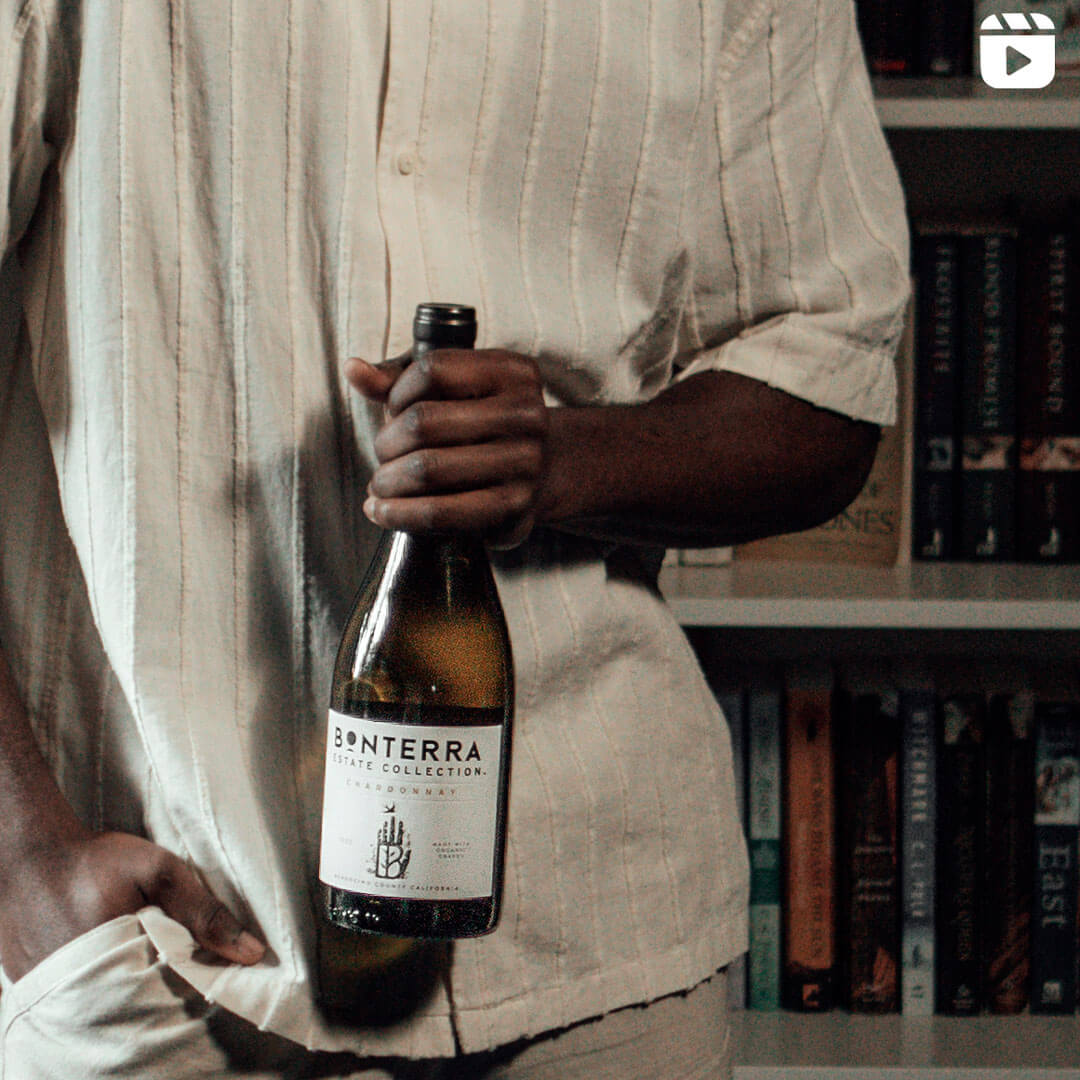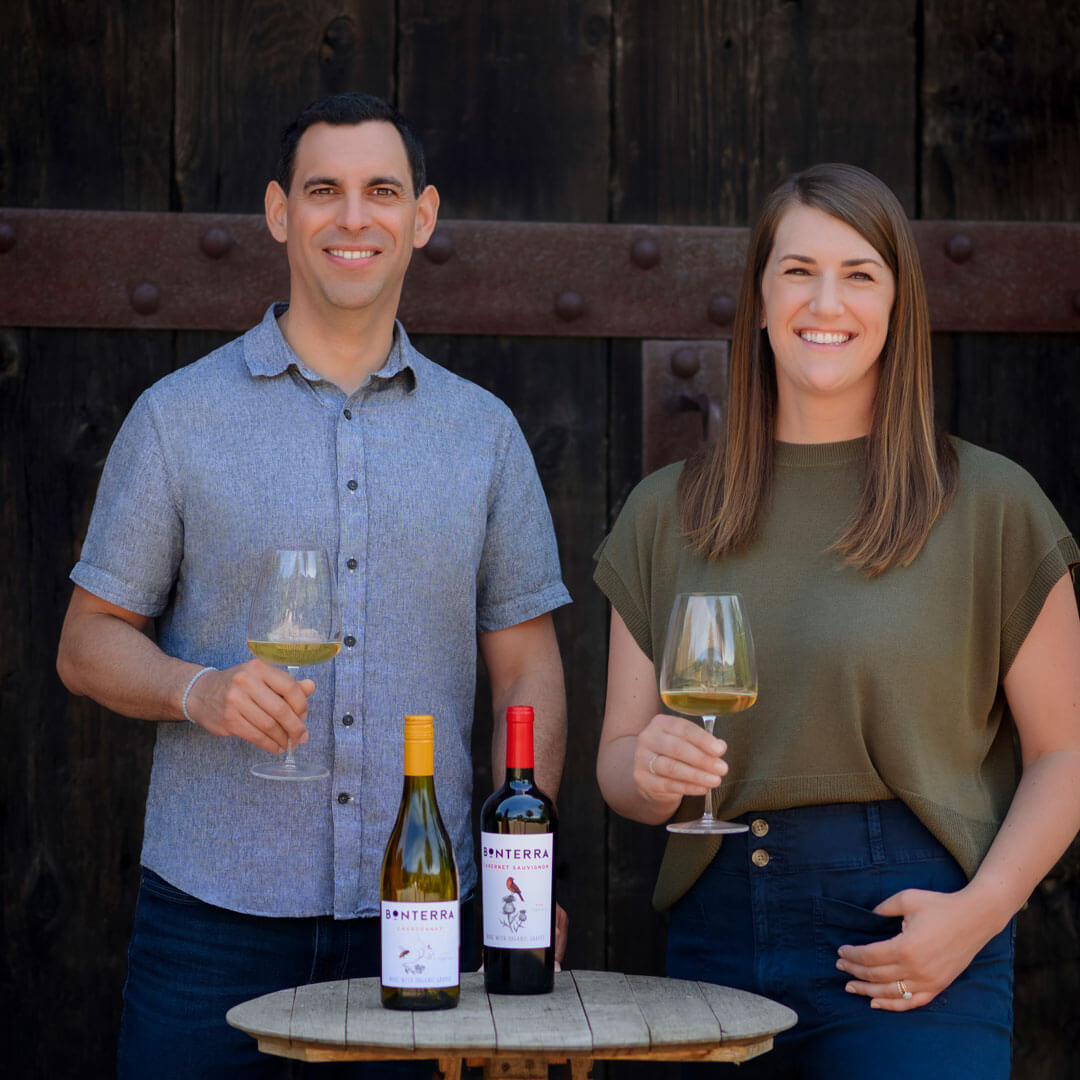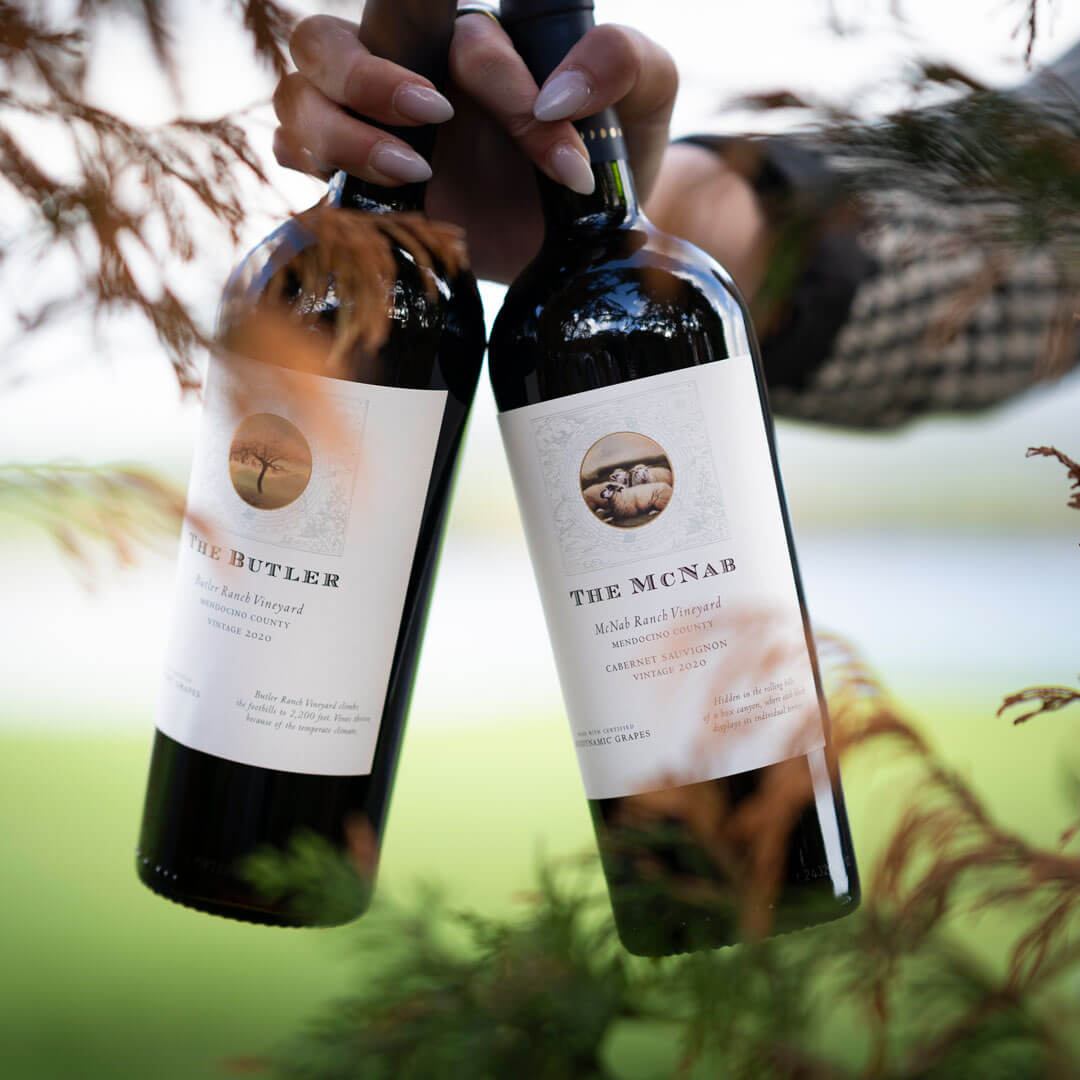It’s one of the most common questions we hear: Is Chardonnay a dry wine—or is it sweet? The short answer? Typically dry. But the real answer—like great wine—is a bit more layered.
That’s because the Chardonnay grape is a shape-shifter. From lean and mineral to round and creamy, its style can vary widely depending on where it’s grown and how it’s made. Add in the way individual palates perceive sweetness in wine, and it’s no wonder this crowd-pleasing varietal keeps people guessing.
At Bonterra, where our wines begin with organically farmed grapes and minimal intervention, we think understanding these nuances makes every sip more rewarding. So let’s clear the confusion and unpack what really influences how Chardonnay tastes—and how to find the right bottle for your palate.
The Technical Answer: Chardonnay Is Typically Dry
From a technical standpoint, many quality Chardonnays like our Bonterra Chardonnay are fermented to dryness, meaning nearly all of the grape’s natural sugars are converted into alcohol during fermentation. In wine terms, “dry” refers not to how a wine feels on the palate, but to the absence of perceptible sweetness from residual sugar. Most well-crafted dry wines contain three grams or less of residual sugar per liter—well below the threshold at which most people begin to detect sweetness.
But as any Chardonnay lover will tell you, perception doesn’t always match the specs. A wine can be analytically dry and still come across as soft, ripe, or creamy on the palate—especially when other elements like oak, fruit expression, and malolactic fermentation come into play. This is where winemaking becomes as much art as science.
Why Chardonnay Sometimes Tastes Sweet (Even When It’s Not)
If most quality Chardonnay wines contain minimal residual sugar, why do some wines still taste sweet to us? This intriguing disconnect between technical dryness and sensory perception comes down to a few key factors that shape how we experience different types of wine:
Fruit Ripeness and Climate Influence
Where Chardonnay is grown has a major impact on its flavor profile. In warmer climates—like parts of California, Australia, and South America—grapes ripen more fully, developing rich fruit flavors like golden apple, pineapple, and mango. These ripe notes can suggest sweetness to our palates, even when the wine itself is dry.
Take our Bonterra Estate Chardonnay, a premium white wine sampler, grown in Mendocino County’s sun-drenched vineyards. Here, warm days encourage lush fruit flavors, while cool, coastal-influenced nights preserve vibrant acidity. The result is a bright, balanced Chardonnay with notes of poached pear, cantaloupe, and apricot—flavors that feel plush and generous, even as the wine remains refreshingly dry.
Oak Aging: The Sweet Factor
One of the biggest contributors to Chardonnay’s perceived sweetness isn’t sugar at all—it’s oak. When Chardonnay wine is aged in oak barrels—especially new American oak—it absorbs naturally occurring compounds that impart notes of vanilla, coconut, caramel, and butterscotch. These aromas aren’t sweet in a technical sense, but they tap into the same pleasure receptors as sweetness, creating what we might call an aromatic sweetness.
At Bonterra, our approach to oak is one of thoughtful restraint. We use partial oak aging with subtler French oak to build texture and complexity, while preserving the vibrant character of our organically grown fruit. The resulting hints of vanilla and gentle spice elevate the wine without overpowering its natural elegance.
Malolactic Fermentation: The Buttery Richness
After primary fermentation—when grape sugars are transformed into alcohol—many Chardonnays go through a secondary step known as malolactic fermentation (sometimes referred to as ML or MLF). This process converts tart malic acid (think green apple) into softer lactic acid (the kind found in cream), creating a rounder mouthfeel and the hallmark buttery notes many Chardonnay lovers adore.
While no sugar is added, this creamy texture and rich flavor profile can enhance the wine’s perceived sweetness, softening its structure and adding a sense of indulgence. It’s a beautiful example of how texture and flavor interact to shape a complete sensory experience—one that transcends simple measurements and invites you deeper into the glass.
Body, Balance, and the Role of Alcohol
Oaked Chardonnay’s alcohol level also plays a quiet but important role in how we perceive the sweetness level. While alcohol itself isn’t sweet, it contributes to the wine’s body and texture, which can enhance the impression of richness and amplify ripe fruit character. In wines with rounder mouthfeel and generous alcohol, typically around 13–14.5% for many California Chardonnay wines, these factors can together suggest subtle sweetness, even when the wine is technically dry.
At Bonterra, we harvest at optimal ripeness to achieve balanced alcohol levels, supporting structure and depth without overwhelming the wine’s natural vibrancy. The result is a Chardonnay where fruit, acidity, and texture are beautifully aligned, delivering a seamless, expressive sip.
The Spectrum of Chardonnay Styles
Understanding that most quality Chardonnays are technically dry but may display varying degrees of perceived sweetness, let’s explore the spectrum of styles available. Knowing what shapes these differences makes it easier to find the style that suits your palate best.
Cool-Climate Chardonnay: Crisp and Mineral-Driven
Chardonnays from cooler regions—like Chablis (France), Oregon, New Zealand, and parts of the Sonoma Coast—tend to offer a leaner, more structured expression with less perceived sweetness. These wines often feature:
- Higher acidity, lending a crisp, refreshing character
- Thoughtful oak use that adds texture and complexity without overshadowing freshness
- Flavors of green apple, lemon zest, and stony or flinty minerality
- Minimal or partial malolactic fermentation, preserving brightness and lift
These Chardonnays appeal to those who prefer a more racy, mineral-driven style, where fruit, acid, and texture are in tight, elegant balance. While oak and MLF may be present, they’re often used with restraint—adding nuance rather than weight.
Moderate-Climate Chardonnay: The Balanced Middle Ground
Chardonnays from moderate climates—like select parts of California, including Mendocino and California’s South Central Coast—often strike an elegant balance between richness and freshness. These wines typically show:
- Harmonious acidity that provides structure without sharpness
- Thoughtful oak aging that adds complexity without overwhelming
- Expressive fruity notes such as pear, cantaloupe, and apricot
- Partial malolactic fermentation for subtle richness and texture
Our Bonterra Chardonnay embodies this style, crafted from organically grown grapes sourced from top vineyards across California. It’s a vibrant, approachable wine with layered character—perfect for those who enjoy a Chardonnay that feels both generous and refreshingly balanced.
Warm-Climate Chardonnay: Rich and Generous
Warm-climate regions—like parts of Australia (including Riverina and the Hunter Valley), inland California, and Napa Valley—tend to produce richer, more opulent styles of Chardonnay. While many Napa producers have moved toward greater restraint in recent years, there’s often still a signature plushness to these wines, thanks to the region’s abundant sunshine and naturally ripe fruit character.
- Chardonnays from these climates often feature:
- Ripe tropical fruit notes like pineapple, mango, or banana
- Vanilla, baking spice, or caramel from pronounced oak aging
- Full malolactic fermentation, delivering buttery texture and roundness
- Higher alcohol content, contributing to body and amplifying richness
Though technically dry, this style can create an impression of sweetness—a result of the cumulative effect of ripeness, oak, and texture. For fans of bold, expressive white wines, warm-climate Chardonnay offers an experience that’s undeniably generous.
Truly Sweet Chardonnay: The Exceptions to the Rule
While most quality Chardonnays are dry, there are a few styles that intentionally retain residual sugar—creating wines that are genuinely sweet, not just perceived as such.
Late Harvest Chardonnay
Occasionally crafted as a dessert wine, late harvest Chardonnay is made from grapes left on the vine well past the typical harvest window. This extra time allows sugars to concentrate, resulting in a naturally sweet, lusciously textured wine prized for its decadence and aging potential and often enjoyed in small pours after a meal.
Sweeter-Style Chardonnay
At the other end of the spectrum, some entry-level or Chardonnays may include a touch of residual sweetness. This is often introduced via grape concentrate or unfermented juice—not table sugar—to soften acidity and create a more fruit-forward, approachable style. While less common among premium producers, this style remains popular with drinkers who prefer a rounder, slightly sweet white.
At Bonterra, we take a different approach. Our Chardonnay is crafted from organically grown grapes and fermented to dryness—allowing the wine’s natural balance, vibrant fruit, and layered texture to shine without added sweetness.
How to Choose the Right Chardonnay for Your Palate
Now that we understand Chardonnay is typically dry but can present various sensory experiences, how do you find the style that’s right for you? Here are some practical guidelines:
If You Prefer Wines That Taste “Not Sweet”
Look for these indicators on labels or descriptions:
- “Unoaked” or “Stainless Steel Fermented”
- References to “cool-climate” or “mineral-driven”
- Mentions of “high acidity” or “crisp”
- Cooler regions like Chablis, Oregon, or the Sonoma Coast
- Terms like “lean,” “focused,” or “linear”
If You Enjoy Balanced Expressions
Our Bonterra Chardonnay falls into this category, along with others that mention:
- “Partially oaked” or “subtle oak influence”
- “Balanced acidity”
- References to both fruit and mineral characteristics
- Moderate climate regions like Mendocino, parts of Sonoma, or California’s Central Coast
- Terms like “elegant,” “harmonious,” or “restrained”
If You Prefer Richer, More Lush Expressions
Seek out Chardonnays that mention:
- “Fully oaked,” “new oak,” or “barrel fermented”
- “Malolactic fermentation” or “buttery”
- Warmer regions like parts of Australia
- Descriptors like “creamy,” “rich,” or “opulent”
- Terms such as “tropical fruit” or “vanilla”
The Bonterra Approach: Organic Expression of Terroir
At Bonterra, our philosophy toward Chardonnay—like all our wines—begins in the vineyard. Our commitment to organic farming means we cultivate grapes that fully express their varietal character, free from synthetic pesticides or fertilizers.
This approach yields Chardonnay grapes with pure, vibrant flavors that require less intervention in the cellar. The result is a wine that achieves complexity through natural expression rather than winemaking manipulation—a Chardonnay that finds the sweet spot between freshness and richness, while remaining technically dry.
Our Chardonnay vines grow in harmony with cover crops that naturally balance soil nutrients, and beneficial insects that help naturally manage pests while contributing to a vibrant ecosystem. This balanced environment creates balanced wine—where acidity, fruit expression, and subtle oak influence exist in perfect proportion.
Perfect Pairings: Enhancing Chardonnay’s Character
From lean and citrusy to rich and round, Chardonnay’s wide stylistic range opens the door to equally dynamic food pairings. Understanding how sweetness is perceived—not just measured—can help you craft more intuitive, more delicious combinations at the table.
For Crisper, Mineral-Driven Styles
- Fresh oysters and shellfish
- Light fish preparations with lemon
- Salads with vinaigrette
- Goat cheese
- Cucumber and avocado tartare (plant-based)
- Sushi and sashimi
For Balanced, Moderately Rich Styles (Like Bonterra)
- Roasted chicken with herbs
- Spring veg risotto with cashew cream (plant-based)
- Creamy risotto (especially with spring vegetables)
- Salmon, particularly cedar-plank preparations
- Lobster or crab with drawn butter
- Soft cheeses like Brie or Camembert
For Fuller, Oak-Influenced Styles
- Creamy pasta dishes
- Roasted winter squash
- Grilled pork with fruit compote
- Miso mushroom with sweet potato gratin (plant-based)
- Dishes featuring wild mushrooms
- Aged cheeses with nutty characteristics
Chardonnay’s range is its superpower. Whether crisp or creamy, lean or plush, it brings something compelling to the table—especially when its style and perceived sweetness are matched with intention. Get the pairing right, and even a simple meal becomes something worth remembering.
The Temperature Factor: Revealing True Character
Serving temperature plays a subtle but important role in how Chardonnay shows up in the glass. When served too cold—straight from the fridge at around 38°F—its texture, aromatics, and layered flavors can be muted, making the wine feel less expressive or more simplistic than it truly is.
As we explore in our guide to how temperature affects wine, the ideal range for Chardonnay is typically 48–52°F—cool enough to stay refreshing, but warm enough to let the wine speak for itself. At the right temperature, you’ll get a clearer sense of its true style—whether it’s crisp and citrusy or rich and creamy—and better understand why it might seem sweet, even when it’s not.
Embrace the Nuance
The question “Is Chardonnay dry or sweet?” opens the door to something much deeper: the beautiful complexity of wine appreciation. While most quality Chardonnays are technically dry, their diversity of flavor and feel comes from the interplay of growing conditions, winemaking choices, and personal perception—things that transcend simple measurements.
At Bonterra, we craft a range of Chardonnays that reflect this expressive spectrum—from our fresh, balanced California Chardonnay to our richer Estate Chardonnay and the site-driven elegance of The Roost Single Vineyard Chardonnay. Each is shaped by our organic farming principles and our belief that the most compelling wines strike a thoughtful balance: richness without heaviness, brightness without austerity.
Whether you gravitate toward the crisp minerality of cool-climate styles, the approachable elegance of Bonterra’s flagship Chardonnay, or a more indulgent, full-bodied expression—like The Roost—understanding the factors that shape your experience helps you find the style that resonates most.
Ready to explore the spectrum for yourself? Shop our Chardonnay bundle and taste the nuance firsthand. After all, wine appreciation isn’t about technical specifications—it’s about finding the bottles that speak to your personal taste. And there’s a Chardonnay out there waiting to tell its story in your glass.
Want to explore more about white wines? Discover how Chardonnay compares to Sauvignon Blanc or dive deeper into wine and food pairing to enhance your enjoyment of our organically farmed wines.




